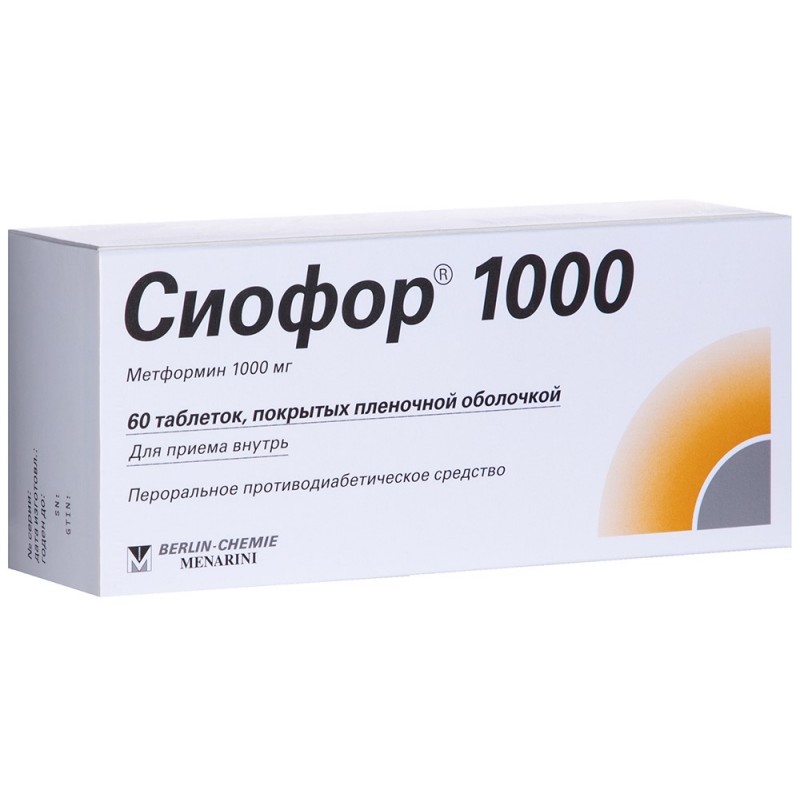




Security policy (edit with Customer reassurance module)

Delivery policy (edit with Customer reassurance module)

Return policy (edit with Customer reassurance module)
Siofor is a hypoglycemic drug from the biguanide group. The mechanism of action of metformin is associated with its ability to inhibit gluconeogenesis, as well as the formation of free fatty acids and fat oxidation.
Metformin does not affect the amount of insulin in the blood, but changes its pharmacodynamics by reducing the ratio of bound insulin to free and increasing the ratio of insulin to proinsulin.
An important link in the mechanism of action of metformin is the stimulation of glucose uptake by muscles and adipose tissue.
Metformin increases blood flow in the liver and accelerates the conversion of glucose to glycogen. In addition, metformin causes a slight anorexigenic effect, which helps patients to keep to a diet and slows down the process of carbohydrate absorption in the intestine.
Reduces triglycerides, LDL, VLDL. Metformin improves blood fibrinolytic properties by suppressing a tissue-type plasminogen activator inhibitor.
Type 2 diabetes mellitus (insulin-dependent), especially in combination with obesity with the ineffectiveness of diet therapy.
- diabetes mellitus type 1 (insulin-dependent);
- complete cessation of insulin's own secretion in the body in case of diabetes mellitus type 2;
- diabetic ketoacidosis, diabetic precoma, coma;
- dysfunction of the liver and / or kidneys;
- myocardial infarction;
- heart failure;
- severe lung disease with respiratory failure;
- severe infectious diseases;
- operations, injuries;
- catabolic states (conditions with enhanced decay processes, for example, with tumor diseases);
- hypoxic states;
- chronic alcoholism;
- lactic acidosis (including a history);
- pregnancy;
- lactation (breastfeeding);
- observance of a diet with caloric restriction of food (less than 1000 kcal / day);
- childhood;
- Hypersensitivity to metformin or other components of the drug.
Gastrointestinal: abdominal pain, diarrhea, metallic taste in the mouth, nausea, vomiting, anorexia (side effects decrease with a gradual increase in the dose; discontinuation of treatment and dose reduction is not required).
Hemic and lymphatic: in isolated cases - the development of megaloblastic anemia.
Other: rarely - skin allergic reactions.
Precautions should appoint Siofor patients over 65 years.
Before the appointment of the drug, as well as every 6 months it is necessary to monitor the function of the liver and kidneys.
It is necessary to control the level of lactate in the blood at least 2 times a year.
Zyofor should be replaced with another hypoglycemic drug (for example, insulin) 2 days before the X-ray examination with IV injection of contrast agents, as well as 2 days before the operation under general anesthesia and continued for 2 more days after this examination or operation.
In extremely rare cases (with an overdose of the drug, in the presence of concomitant diseases, with alcoholism) lactic acidosis may develop.
The results of clinical studies aimed at studying the hypotensive effect of metformin suggest that the drug affects the daily blood pressure profile in patients with clinical manifestations of the metabolic (insulin-resistant) X syndrome.The hypotensive effect of metformin is most likely directly related to a decrease in insulin resistance and hyperinsulinemia, which play an important role in the activity of the sympatho-adrenal system.
Influence on ability to drive motor transport and control mechanisms
When using Siofor, it is not recommended to engage in activities that require concentration of attention and quick psychomotor reactions due to the risk of hypoglycemia.
Enhancement of the hypoglycemic effect of Siofor is possible while taking it with other hypoglycemic drugs (sulfonylurea derivatives, insulin), salicylates (including acetylsalicylic acid), MAO inhibitors, oxytetracycline, ACE inhibitors, beta-blockers.
Reducing the hypoglycemic effect of the drug is possible while taking glucocorticoids, oral contraceptives, thyroid hormones, phenothiazine derivatives, diuretics, nicotinic acid derivatives, sympathomimetics.
When prescribing Siofor against the background of the use of indirect anticoagulants - coumarin derivatives, it is necessary to carefully monitor blood clotting parameters.
Taking cimetidine may increase the risk of lactic acidosis.
With simultaneous use with ethanol increases the risk of severe adverse reactions (hypoglycemia, lactic acidosis).
Symptoms: lactic acidosis (nausea, vomiting, diarrhea, abdominal pain, severe weakness, muscle pain, rapid breathing, confusion and loss of consciousness); hypoglycemia may develop, accompanied by pallor of the skin, tachycardia, hunger, increased sweating, tremors, and in severe cases, impaired consciousness.
Treatment: if the patient is conscious, glucose or sugar solution is administered orally. With loss of consciousness injected into / in 40% glucose solution. After the restoration of consciousness in order to avoid the recurrence of hypoglycemia, it is necessary to give the patient food rich in carbohydrates.
The drug should be stored at room temperature, protected from light.